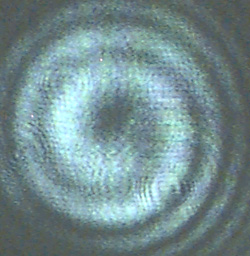Breaking Free of Bits

Quantum communication schemes using light normally rely on the two types of photon polarization to encode information a bit at a time. But if researchers could efficiently measure a photon’s orbital angular momentum, which can take an infinite number of different values, they could conceivably pack much more information into a light beam. Now, in the 24 June print issue of PRL, a team reports a way of sorting individual photons according to their orbital angular momentum, which could allow them to make use of all that extra data.
Photons have two spin states, which correspond to the two types of circular polarization for a light beam: the electric field rotates either clockwise or counterclockwise. A cross-section through such a beam would have the electric field synchronized everywhere, so that at a given time it points in the same direction at every point in the plane. In a beam with orbital angular momentum ( L), however, the field at different points around the beam axis will rotate out of phase. The field at 12 o’clock, for example, might point up when the field at 6 o’clock points down, corresponding to a beam with L=1. Each of the beam’s photons varies in space just as the electric field does. Researchers hope to use a beam’s L values as an alphabet for optical messages.
Until now, however, sorting single photons–rather than entire beams–based on their L values has not been possible. To make this leap, Miles Padgett and Johannes Courtial of the University of Glasgow, and their colleagues, routed light through a beam splitter into two arms, each of which contained a prism capable of rotating the light but leaving it otherwise unchanged.
The technique takes advantage of symmetry. For light with an even L value, a half-turn results in no detectable change; not so for light with an odd value. When the two offset beams come back together in the interferometer’s second beam splitter, the photons are sorted based on whether the two beams are identical (constructively interfere) or not. To discriminate between four different L values, the team sent the sorted beams through additional interferometers, set to rotate at other angles. Using filters, the group was able to lower the intensity of the light to the point that only a single photon existed in the set-up at a time.
So far the group has gone only to the second stage of sorting. In principle, says team member Jonathan Leach, a graduate student at the University of Glasgow, you can keep sorting until you run out of beam splitters and prisms, or, more likely at this stage, patience. With six pieces for each device, “it’s a bit of a nightmare to keep all the interferometers aligned at any one time,” he says, adding that he’s working on making them sturdier and therefore easier to combine. The group also plans to add elements that will sort the light based on its polarization state, allowing them to extract even more information per photon.
Measuring the orbital angular momentum of single photons is a “brilliant” achievement, says Keith Burnett of the University of Oxford. It should have significant consequences for studies of quantum information, cryptography, and entanglement, he notes. “It is also a most elegant experiment.”
–JR Minkel
JR Minkel is a freelance science writer in New York City.


